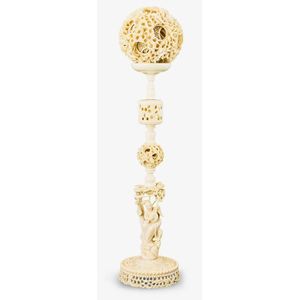Ivory Dragon Puzzle Ball with Maiden Base
You must be a subscriber, and be logged in to view price and dealer details.
Subscribe Now to view actual auction price for this item
When you subscribe, you have the option of setting the currency in which to display prices to $Au, $US, $NZ or Stg.
- Ivory - Ivory is a hard white material that comes from the tusks of elephants, mammoth, walrus and boar, or from the teeth of hippopotamus and whales. The ivory from the African elephant is the most prized source of ivory. Although the mammoth is extinct, tusks are still being unearthed in Russia and offered for sale.
Ivory has been used since the earliest times as a material for sculpture of small items, both in Europe and the east, principally China and Japan.
In Asia ivory has been carved for netsuke, seals, okimono, card cases, fan supports, animals and other figures and even as carved tusks.
In the last 200 years in Europe ivory has been used to carve figures, for elaborate tankards, snuff boxes, cane handles, embroidery and sewing accessories, in jewellery and as inlay on furniture. Its more practical uses include being used for billiard balls, buttons, and a veneers on the top of piano keys.
The use and trade of elephant ivory have become controversial because they have contributed to Due to the decline in elephant populations because of the trade in ivory, the Asian elephant was placed on Appendix One of the Convention on International Trade in Endangered Species (CITES), in 1975, and in January 1990, the African elephant was similarly listed. Under Appendix One, international trade in Asian or African elephant ivory between member countries is forbidden. Unlike trade in elephant tusks, trade in mammoth tusks is legal.
Since the invention of plastics, there have been many attempts to create an artificial ivory - A/f, as Inspected - The letters "A/F" or "as inspected" as part of a description is the cataloguer's shorthand for "all faults" or "as found", meaning the item has some type of damage or deficiency, it is of uncertain date or provenance, and/or that the seller takes no responsibility for the completeness of the item or the accuracy of the description.
This item has been included into following indexes:
Visually similar items

Very large Cantonese ivory puzzle ball and stand, 19th century, the outer layer of the ball finely carved and pierced with scrolling dragons and clouds, the stand with a rotating upper section carved with a dragon and a smaller puzzle ball, all supported b

A carved Chinese puzzle ball on stand, the ball of approximately 10 concentric levels, the outermost carved as sinuous dragons, raised upon a turned carved and pierced stand, the uppermost support absent. Height 35.5 cm

A Chinese ivory carved puzzle ball, the ball of 5 cm. diameter carved with dragons, raised on a stand carved with landscape and figures. Overall height 21.5 cm

Large Cantonese ivory puzzle ball and stand, 19th century, the outer layer of the ball finely carved and pierced with scrolling dragons and clouds, the stand with an upper section carved with geometric design and a smaller puzzle ball, all supported by the
